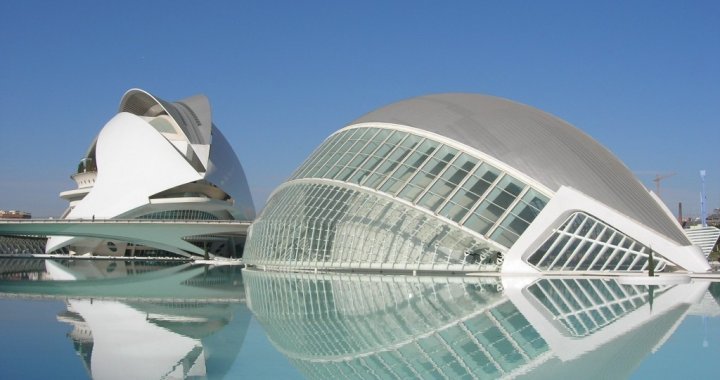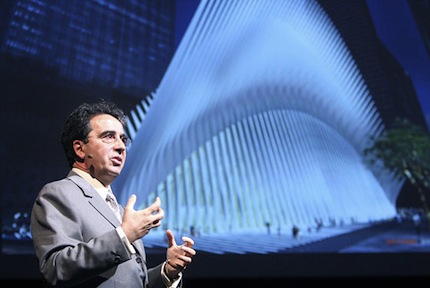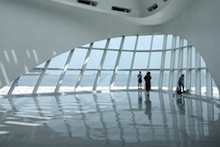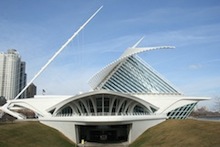
The Three Faces of Santiago Calatrava
Kristīne Budže
27/06/2012
The “Santiago Calatrava: The Quest for Movement” exhibition can be seen at the State Hermitage Museum in St. Petersburg from June 27 to September 30.
The State Hermitage Museum in St. Petersburg wants to give a fresh face to its image as a repository of unthinkable reserves of art history, also presenting itself as a contemporary and modern art institution. Proof of this new image is the planned series of architecture exhibitions, “Hermitage 20/21”. The collection of the State Museum holds a huge store of architectural graphics, covering a period between the 17th and 19th centuries. However, this is not enough for the Hermitage, and the end of June will see the opening of the first exhibition featuring a retrospective of a contemporary architect. Santiago Calatrava (1951) – Spanish architect, engineer, sculptor and painter – has been chosen as its star. The director of the Hermitage Museum draws a parallel, saying that no one could suit the Russian city of bridges better than master of some of the most stunning bridges from the turn of the century. Typically of 21st century displays of architecture, the exhibition will present not just models and project information on Calatrava’s most well-known buildings, but also large-format paintings and sculptures created especially for the retrospective by the architect himself. While this is the first exhibition in the Hermitage devoted to contemporary architecture, it is not the first time Calatrava’s work has been displayed in a museum. In 2003, New York’s Metropolitan Museum of Art showed an ambitious exhibition of the architect’s work, “Santiago Calatrava. Sculpture into Architecture” – the largest show devoted to a living architect the museum had ever hosted.

Santiago Calatrava
Director of the Hermitage Museum has called Calatrava’s exhibition a bridge from 19th century St. Petersburg to the new millennium. To tell the truth, this bridge largely comes to a stop in the first decade of the 21st century. Calatrava belongs to a group of architects from the end of the 20th and beginning of the 21st century who have been forever affected by the global economic crisis of the first decade of the millennium, and their careers – although by no means over – can be talked about as a global pre-crisis phenomenon, characteristic of more prosperous years. Architects like him belong to the past and have difficulties adapting to the architectural paradigm of the new economic situation; one that focuses on social responsibility, energy efficiency, taking the role of a curator of social processes, and teamwork. Santiago Calatrava remains the embodiment of the 20th century definition of a genius – perceiving architecture as an individual work of art rather a collective research project. Indeed, he is the Leonardo da Vinci of architecture at the turn of the 20th and 21st centuries - an architect, an engineer, and an artist at the same time.
The First Face – Artist
Calatrava calls himself an artist, and not just because he mastered the basics of art during his early school years, only deciding on architecture studies as a late teenager upon discovering Le Corbusier’s ability of combining the creative expression of an architect, a sculptor and a painter in such a wonderful manner. It is also not because the Spaniard paints and creates sculptures to this day, mostly displaying them at his villa in Zurich. He considers architecture to be the highest form of art, reflecting that historically, architecture has always been seen as belonging to the world of art. Speaking about the various aspects of his projects, Calatrava constantly alludes to the work of painters and sculptors, comparing his own approach to architecture with their artistic expression. He also admits to solving architectonical problems by learning from the example of artists searching for answers to their questions. Calatrava finds the irrational and poetic nature of architecture important – a luxury seldom afforded by architects in the new global economic situation.


%20copy.jpeg)
Milwaukee Art Museum, Wisconsin
The aesthetics and emotional impact of his buildings are often seen as their inherent value, absolving their huge construction and operation costs, as well as unpractical details and often far from flawless functionality. However, Calatrava knows how to create the mark of a place, attracting crowds of tourists and causing such surprise that, for a moment, the function of architecture as a building to be used and not just an object of admiration is forgotten. Calatrava acts as a reminder that a building needs a soul, which can only be injected by a creative architect taking the role of a priest. It is said that the Spanish architect’s buildings should be understood with the heart more than the mind. Lately, Calatrava’s own mind is more and more concerned with the thought of including his works of painting and sculpture within the architecture of his buildings. Here, he turns his coat and invokes examples from the Renaissance, where a building’s form is secondary to the paintings inside, such as the Sistine Chapel in the Vatican.
The Second Face – Engineer/ Inventor
After studies in architecture in his native Valencia, Calatrava also received an education in civil engineering at the Federal Institute of Technology in Zurich. He notes that architects are usually not engineers, while engineers are not involved in creating the architectonic character of a building. They study at different schools, and although they know from the very beginning that they will have to work together on common projects, they face each other with distrust – just like a sausage maker and a health inspection employee. Calatrava is aware that technology is a vocabulary – with skill, it can be used to express many things. He sometimes resembles a mad inventor, painting his technological fantasies in building and bridge form with watercolours in a sketch pad. The architect’s archive in Zurich holds over a hundred thousand sketches, and Calatrava uses them to explain his ideas to clients instead of PowerPoint presentations. Surprisingly, the colourful paintings of jumping people, eyes and hand skeletons, which at first sight have nothing to do with houses, are later transformed into visually identical buildings. Calatrava enjoys challenging the laws of physics and creating buildings that question them.
Testing his own abilities, as well as those of the engineers and builders involved, he has created buildings with roofs that rise and/or open, buildings that really move or leave a kinetic impression. Calatrava loudly declares that buildings are not like boulders, but rather waves in the sea that come and go; all buildings, even historical ones, move in some way – like Egypt’s pyramids, slowly sinking into the sand. His engineering knowledge helps the architect in creating movement and dynamics. Calatrava’s architecture seems to mimic natural beings – huge insects, birds, petals and human eyes, but he strongly denies such similarities, saying that even the most realistic copy of nature, once created by man, is not nature anymore. It is an abstraction created in the mind – a part of a personal cosmology. Some more about Calatrava’s technical side – he does not use computers in the design process, and although he is the author of many world famous airports, train stations, bus stations and complex traffic hubs, he cannot drive a car himself.
The Third Face - Starchitect
Calatrava is a true child of his time – the end of the 20th and very beginning of the 21st century – only able to transform his creative fantasies into real buildings and bridges during the cult of Frank Gehry’s Bilbao Effect , when the world was thirsty for architectural surprises and shows, and could afford to pay for it. Thus Calatrava is no withered, crazy engineer quietly painting watercolours in a modest home, but rather an elegant gentleman in custom-made suits from France and fancy shoes, with a beautiful villa in Zurich and a number of properties in New York. The business side of the architect’s office is run by his wife, Robertina, whom Calatrava met while studying in Switzerland, where the Swedish-raised businessman’s daughter was reading law. Although the architect himself insists that his name is not a brand, his status as starchitect has helped him gain a series of commissions, as well as convincing clients in cases when the cost of a project has by far surpassed the initially estimated figures, or when some of the proposed engineering experiments have gone wrong and functionality of a building is lacking. Such scandals and technical problems dog almost all of the architect’s projects – something that was tolerated in pre-crisis times, but cannot be forgiven now, with Calatrava being made to choose less expensive engineering solutions, abandon visual extravagances or cancel commissions altogether. However, remaining self-assured and at peace, the architect himself adds that Rembrandt also left many paintings unfinished.
More information:
www.hermitagemuseum.org
www.calatrava.com